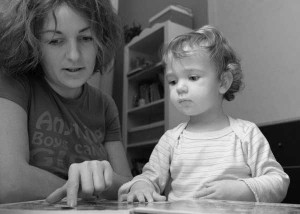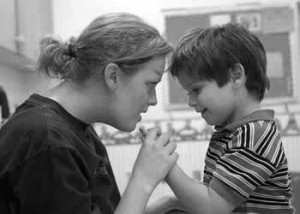Once parents have a diagnosis, research must begin for intervention, since it has been proven that early intervention greatly benefits children (Lovaas, 1987). While the types of intervention vary in their approach to helping diminish the signs of autism, most of them are not scientifically proven to be effective.

Applied Behavioral Analysis (ABA), however, is the only scientifically based treatment available for autistic children (McEachin et al., 1994; Lovaas, 1987). As an experienced ABA therapist, ABA incorporates discrete trial teaching in which skills are broken down into minute components and systematically taught to children on a one-to-one basis. For example, since many autistic children lack imitation, ABA first teaches imitation of objects, then of body movements to finally following the leader as a way for them to naturally imitate from others (Bohdanna Popowycz Kvam, personal communication Novemeber 1, 2002). In 1987, Ivar Lovaas conducted a study on the effects of ABA on autistic children under the age of 4 with IQ scores falling in the mild to retarded category. The experimental group of 19 children received 40 hours a week of one-to-one intensive therapy while the first control group only received 10 hours a week and the second control group did not receive intensive behavioral treatment through Lovaas’ Young Autism Project (Lovaas, 1987). His short-term goals consisted of teaching compliance, imitation and appropriate toy play that many autistic children lack, generalizing treatment in the community, and reducing self-stimulatory behaviors such as hand-flapping (Lovaas, 1987). Long-term goals that were emphasized in years two and three of therapy consisted of teaching receptive and expressive language, playing with peers, teaching emotions, pre-academic skills such as reading and writing, and observational learning (Lovaas, 1987). Results and follow-up data reveal that subjects in the experimental group gained an average of 30 IQ points, and were higher than both control groups in school and intellectual functioning (Lovaas, 1987).

Of the 19 children in the experimental group, 47% achieved normal or above average IQ scores, went on to a normal first grade, and were indistinguishable from their peers (Lovaas, 1987). Subjects in both control groups had IQ scores that remained stable over time (Lovaas, 1987). McEachin, Smith and Lovaas (1993) went on to evaluate the long-term outcome of children in Lovaas’s 1987 study at a mean age of 11 ½. McEachin et al. (1993) found that the 19 children in the experimental group maintained their level of intellectual functioning and had higher scores than the control groups on adaptive behavior and personality. The children in the control groups did not gain such an outcome. In contrast, they fared poorly, which coincides with the poor prognosis of autistic children if no early intervention was administered (McEachin et al., 1993). McEachin et al. (1993) went on to state that there is reason to believe that alterations in neurological structures are possible as a result of change in the environment in the first few years of life for young children with autism, based on past studies on laboratory animals (as cited by Rutter & Schopler, 1987).
Early assessment and detection can make an extraordinary difference in the lives of autistic children. Although there was no standardized list for diagnosing autism prior to the Diagnostic Statistical Manual of Mental Disorders, Third Edition, many new assessment tools have been developed such as the CARS and CHAT (Baron-Cohen et al.,1992; Ritvo et. al, 1989) in helping with early detection. As well, before Lovaas’ research experiment on ABA, the prognosis of autism was considered to be, “very poor, and medical therapies [did] not [prove] effective” (Lovaas, 1987, p.3). Upon testing the effectiveness of ABA, Lovaas (1987) soon witnessed that behavior modification does work with autistic children to a point of bringing some of them to a normal IQ level. Currently, Lovaas (1987) revolutionized the way we think about autism; no longer is autism thought of as a, “[severe], lifelong disability” (Maurice, 1993, p.22), but is now viewed as a temporary halt in development in which ABA can “re-map” the brains of children with autism to learn from their environment.
Related posts:
- A General Overview of Autism and ABA Therapy The use of ABA therapy to teach child autism has...
- Understanding Autism and Autism Treatments It was my father who gave me my first gut-level...
- Screening Tests for Autism There are many assessment tools for detecting autism in children,...
Comments are closed.